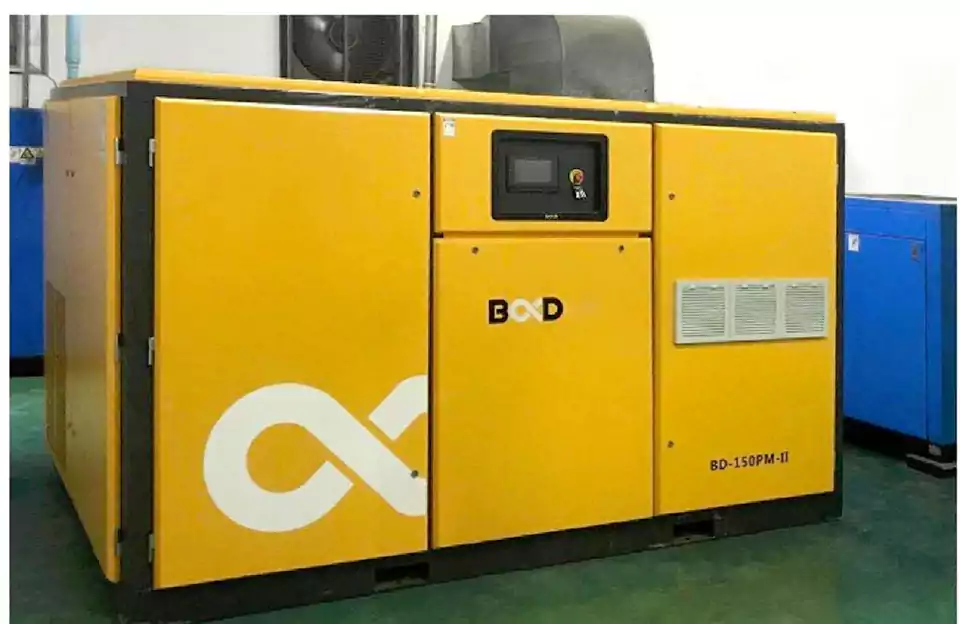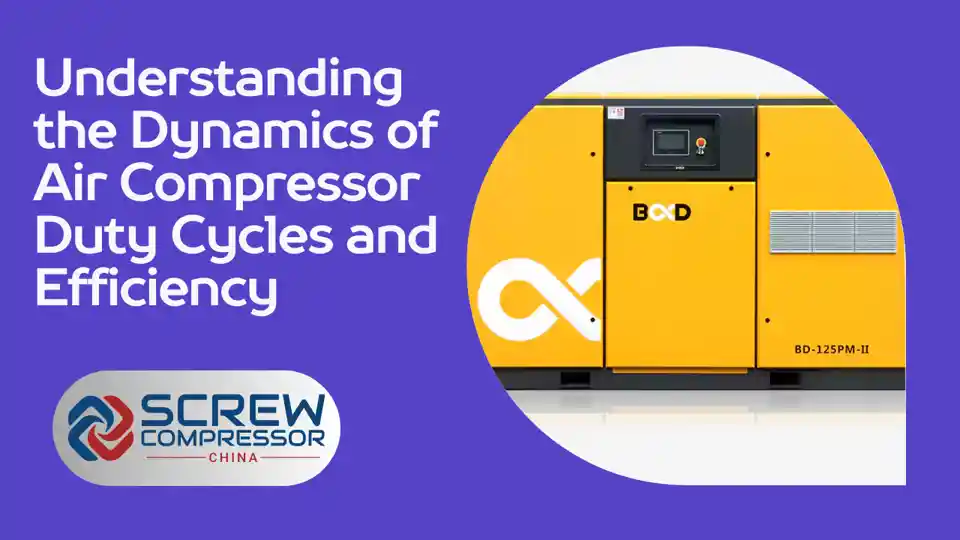Introduction
Air compressors are integral to numerous industrial applications, providing the necessary power for various tools and processes. Understanding the duty cycles, efficiency, and power requirements of air compressors can significantly enhance their operation and longevity. This article delves into the key aspects of air compressor functionality, emphasizing duty cycles and efficiency enhancements.
Comprehending Air Compressor Duty Cycles
What is a Duty Cycle?
The duty cycle of an air compressor refers to the percentage of time it can operate continuously before it needs to rest. This is crucial for preventing overheating and maintaining the efficiency of the compressor.
A duty cycle is typically expressed as a percentage, indicating the proportion of time the compressor is actively running within a given cycle. For example, a 50% duty cycle means the compressor runs for half the total cycle time and rests for the other half.
![]()
Duty cycles are particularly important in industrial settings where air compressors are subjected to continuous or intermittent operation. Matching the duty cycle to the application’s demands is essential for optimal performance and longevity. Overworking a compressor beyond its rated duty cycle can lead to overheating, accelerated wear and tear, and potential breakdowns.
It’s worth noting that duty cycle also relates to the pressure (PSI) and flow (CFM) delivered during the active portion of the cycle. A compressor advertised with a 100% duty cycle might provide a specific PSI and CFM continuously, while the same compressor could be rated at a 50% duty cycle when delivering a higher PSI at a lower CFM. The duty cycle is intrinsically tied to the application’s requirements and the necessary PSI and CFM to fulfill them.
Learn more about the basics of duty cycles from What You Need to Know About Air Compressor Duty Cycles.
Calculating Duty Cycle
The formula for calculating the duty cycle is straightforward: it is the ratio of the compressor’s running time to the total cycle time (running plus resting time). To calculate the duty cycle percentage, divide the compressor’s run time by the total cycle time and multiply by 100.
For example, if a compressor runs for 8 minutes within a 10-minute total cycle time, the duty cycle would be:(8 minutes / 10 minutes) x 100 = 80%
This means the compressor is actively delivering compressed air for 80% of the cycle and resting for the remaining 20%.
For practical guidance on calculating this, see How to Calculate Duty Cycle.
Optimizing Compressor Power and Efficiency
Power Calculation for Compressors
Accurate power calculation is essential for ensuring that air compressors operate within their capacity without wastage of energy. Calculating the power requirements involves considering factors such as the compressor’s flow rate, pressure, and efficiency.
The basic formula for calculating compressor power is:Power (kW) = (Flow Rate (m³/min) x Pressure (bar)) / (Efficiency x 6.3)
Where:
- Flow Rate is the volume of air delivered per unit time
- Pressure is the desired output pressure
- Efficiency is the compressor’s overall efficiency (typically ranging from 0.7 to 0.9)
It’s important to note that this is a simplified formula, and more precise calculations may involve additional factors such as altitude, temperature, and specific compressor characteristics.
For a detailed look at how to calculate the power requirements of compressors, check out Compressor power calculation.
Enhancing Compressor Efficiency
Improving the efficiency of air compressors involves several strategies, such as using energy-efficient models, maintaining proper servicing schedules, and optimizing the operation environment. Some key considerations for enhancing compressor efficiency include:
- Selecting the right compressor size and type for the application
- Implementing proper maintenance practices, such as regular filter changes and leak detection
- Optimizing the compressor’s operating parameters, such as pressure and temperature
- Utilizing variable speed drives to match compressor output to demand
- Recovering and reusing waste heat generated by the compressor

For advanced insights into rigorous compressor calculations, visit Compressor Calculations: Rigorous Using Equation of State vs. Shortcut Method.
Extending the Duty Cycle
Techniques to Extend Duty Cycle
To extend the operational time of your compressor without compromising its efficiency, consider implementing enhanced cooling systems, using variable speed drives, and selecting compressors with better duty cycle ratings. Here are some specific techniques to extend the duty cycle:
- Upgrade to a larger air receiver tank: A larger tank allows for longer compressor run times and fewer cycles, reducing wear and tear on the compressor.
- Implement a wider pressure band: Increasing the pressure differential between the compressor’s cut-in and cut-out points can lengthen the cycle time, allowing for longer run periods and more efficient operation.
- Optimize the pressure settings: Lowering the pressure settings, if feasible for the application, can reduce the compressor’s workload and extend its duty cycle.
- Improve cooling efficiency: Enhancing the compressor’s cooling system, such as upgrading to a more efficient aftercooler or improving ventilation, can help dissipate heat more effectively and prolong the compressor’s run time.
- Utilize variable speed drives: Variable speed drives can adjust the compressor’s output to match the demand, reducing the number of start-stop cycles and extending the duty cycle.
As discussed in What Is Air Compressor Duty Cycle, these techniques can help optimize the compressor’s performance and longevity.
Frequently Asked Questions
Q: How do I calculate the duty cycle of my air compressor?
A:To calculate the duty cycle, divide the total running time of the compressor by the sum of the running and resting times. For example, if a compressor runs for 6 minutes and rests for 4 minutes, the duty cycle would be:(6 minutes / (6 minutes + 4 minutes)) x 100 = 60%
For a step-by-step approach, refer to this article on duty cycle calculation.
Q: What are the main factors that affect compressor efficiency?
A:Key factors include the type of compressor, the specific design, maintenance frequency, and the operational environment. Compressor efficiency is influenced by aspects such as:
- Compressor technology (e.g., reciprocating, rotary screw, centrifugal)
- Motor efficiency
- Pressure and flow requirements
- Cooling system effectiveness
- Maintenance practices (e.g., filter changes, leak detection)
- Ambient temperature and humidity
Q: How can I improve the power efficiency of my compressor?
A:Regular maintenance, using the correct size and type of compressor for your needs, and optimizing your system for the specific operational parameters are effective strategies. Some specific ways to improve power efficiency include:
- Conducting regular maintenance to ensure optimal performance
- Selecting a compressor with the appropriate capacity for your application
- Implementing variable speed drives to match output to demand
- Optimizing pressure settings to avoid over-compression
- Recovering and reusing waste heat generated by the compressor
- Fixing air leaks and ensuring proper system sizing
Conclusion
Understanding and managing the duty cycle and efficiency of air compressors is vital for maximizing performance and longevity. By applying the insights and techniques discussed in this article, users can achieve more sustainable and efficient compressor operation.
Learn more about enhancing air compressor performance and duty cycles by exploring detailed studies and technical resources.
Explore our range of high-quality rotary screw air compressors and air compressor parts to find the perfect solution for your industrial needs.
